(PDF) Advances in Virus Research – Research Advances in Rabies By Alan C. Jackson
$22.00
Download instantly Advances in Virus Research – Research Advances in Rabies By Alan C. Jackson. It is ebook in PDF format.
ISBN-10: 0123870402 ISBN-13: 9780123870407
Preview
This is the PDF eBook version for Advances in Virus Research – Research Advances in Rabies By Alan C. Jackson
Table of Contents
Preface
Rabies Virus Transcription and Replication
I. Introduction
II. Molecular Aspects of Viral Transcription and Replication
III. Structural Aspect of RABV Transcription and Replication; Proteins Involved in Transcription and Replication
IV. Cellular Aspect of Rabies Transcription and Replication: IBs Formed in Infected Cells Are the Sites of Viral RNA Synthesis
V. Concluding Remarks
Acknowledgments
Rabies Virus Assembly and Budding
I. Introduction
II. Rabies Virus M Protein
III. The Central Role of M and Supporting Role of G in RABV Budding
IV. Features of M Protein Important for Budding
V. Viral L-Domain/Host Interactions
VI. Ubiquitination and RABV Budding
VII. Summary
Acknowledgments
Evasive Strategies in Rabies Virus Infection
I. Introduction
II. Evasion from host immune responses
III. Preservation of neuron and neuronal network integrity
IV. Conclusions on RABV Evasive Strategies
Rabies Virus Clearance from the Central Nervous System
I. Introduction
II. Rabies Virus
III. Animal Reservoirs of the Rabies Virus and the Threat of Human Rabies
IV. Human Rabies
V. The Current Rabies Postexposure Treatment Paradigm
VI. Obstacles in Clearing Wild-type Rabies Virus from the CNS
VII. Prospects for Human Rabies Immunotherapy Through Virus Clearance From the CNS
Acknowledgments
Role of Chemokines in Rabies Pathogenesis and Protection
I. Introduction
II. Chemokines
III. The Role of Chemokines in the CNS When Infected by Viruses
IV. Induction of Chemokine Expression in RABV Infections
V. Overexpression of Chemokines Can Benefit the Host If the Expression Is Transient While It Harms the Host If the Expression Is Persistent During RABV Infections
VI. Chemokines Expression Correlates with the Activation of Dendritic Cells and Enhancement of Adaptive Immunity
VII. Recombinant RABV Expressing Chemokines/Cytokines Can Be Used Effectively to Prevent the Development of Rabies
VIII. Summary
Acknowledgments
Interferon in Rabies Virus Infection
I. Introduction
II. Rabies and Interferon
III. Conclusions and Future Outlook
Acknowledgments
The Role of Toll-Like Receptors in the Induction of Immune Responses During Rabies Virus Infection
I. Toll-Like Receptors
II. Rabies in MyD88-Deficient Mice
III. The Host Response to Rabies Infection Involves TLR7
IV. The Contribution of TLR7 Signaling to the Control of Rabies Virus Spread to the CNS and Clearance from CNS Tissues
V. TLR7 and the Diverse Pathogenicities of Rabies Virus Variants
VI. Conclusions and Relevance to Therapeutic Immunization
Acknowledgments
Role of Oxidative Stress in Rabies Virus Infection
I. Introduction
II. Degeneration of Neuronal Processes in Experimental Rabies
III. Cultured Dorsal Root Ganglion Neurons for Studying Neuronal Process Degeneration
IV. Oxidative Stress
V. Oxidative Stress in Rabies Virus Infection
VI. Conclusions
Acknowledgments
Rabies Virus as a Research Tool and Viral Vaccine Vector
I. Rabies Virus as a Research Tool
II. The Need for Novel Vaccines for RABV
III. Modified Replication-Competent RABV as Rabies Vaccines for Wildlife
IV. RABV-Based Vectors as Vaccines Against Other Infectious Diseases
V. Safety: Generating Safer RABV Vaccines and Vectors for Use in Humans
VI. Replication-Deficient or Single-Cycle RABV
VII. Potential Novel Human Rabies Vaccines Based on Replication-Deficient RABV
VIII. Replication-Deficient/Single-Cycle RABV as Vaccine Vector
IX. Killed RABV–RABV Proteins as Carriers of Foreign Antigens
Rabies Virus as a Transneuronal Tracer of Neuronal Connections
I. Introduction
II. Differences in Properties of Alpha-Herpesviruses and Rabies Virus as Transneuronal Tracers
III. Rabies Virus
IV. Perspectives
Acknowledgments
Molecular Phylogenetics of the Lyssaviruses—Insights from a Coalescent Approach
I. Introduction
II. Lyssavirus Phylogeny
III. Lyssavirus Phylogeography
IV. Lyssavirus Adaptation
V. Concluding Remarks
Bats and Lyssaviruses
I. Introduction
II. Bat Lyssaviruses: Eurasia and Australasia
III. Bat Lyssaviruses: Africa
IV. Bat Rabies and the Americas
V. Discussion
Acknowledgments
Postexposure Prophylaxis for Rabies in Resource-Limited/Poor Countries
I. Introduction
II. Local Wound Care
III. Evaluation of Risk of Rabies Exposure
IV. Postexposure Prophylaxis of Previously Unvaccinated Patients
V. Postexposure Prophylaxis in Previously Vaccinated Patients
VI. Postexposure Prophylaxis Failures
Neuroimaging in Rabies
I. Introduction
II. Neuroimaging Techniques
III. Neuroimaging in Rabies
IV. Newer Neuroimaging Techniques in Rabies
V. Conclusions
Acknowledgments
Rabies Virus Infection and MicroRNAs
I. Introduction
II. MicroRNAs
III. miRNAs and Viruses
IV. Inhibition of Rabies Viral Replication by siRNA/amiRNA
V. Conclusions
Design of Future Rabies Biologics and Antiviral Drugs
I. Introduction
II. Vaccines
III. Antibodies
IV. Antiviral Drugs
V. Conclusions
Therapy of Human Rabies
I. Introduction
II. Prevention of Rabies
III. Therapy of Rabies
IV. New Approaches
V. Conclusions
Mathematical Models for Rabies
I. Introduction
II. The Development of the Mathematical Approach to Rabies Dynamics
III. Modeling Approaches Using Reaction Diffusion Methods
IV. Methods for Incorporating Landscape Heterogeneities
V. Stochastic Models
VI. Incorporating Stochasticity and Spatial Heterogeneity
VII. Optimal Control
VIII. Conclusions
Acknowledgments
Evolution of Wildlife Rabies Control Tactics
I. Introduction
II. Historical and Contemporary Wildlife Rabies Control Tactics
III. Advances in Rabies Vaccine-Bait Delivery Systems for Wildlife
IV. Advances in Wildlife Rabies Vaccines
V. Advances in the Assessment of Wildlife Vaccination Systems
VI. Advances in Contingency and Management Planning for Wildlife Rabies Control
VII. Advances in Technologies for Studying the Ecology of the Rabies Virus and Wildlife Rabies Vector Species
VIII. Summary
Understanding Effects of Barriers on the Spread and Control of Rabies
I. The Concept and Mechanisms of Barriers
II. Assessing Barrier Effects
III. Assessing Interaction of Vaccination Barriers and Habitat Patterns
IV. Discussion
Acknowledgments
Rabies Research in Resource—Poor Countries




